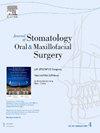以颞动脉为基础的新型耳前复合游离皮瓣修复复杂鼻缺损的微血管重建:附2例报告,关键问题及文献复习。
IF 1.8
3区 医学
Q2 DENTISTRY, ORAL SURGERY & MEDICINE
Journal of Stomatology Oral and Maxillofacial Surgery
Pub Date : 2025-03-24
DOI:10.1016/j.jormas.2025.102319
引用次数: 0
摘要
鼻子的解剖、结构和位置在定义面部美学中起着关键作用。作为非黑色素瘤皮肤癌最常见的部位,在不断发展的重建外科领域中,在消融手术后恢复鼻子的自然外观是一个重大挑战。通过坚持重建手术的原则和面部亚单位划分理论,许多技术已经发展起来,局部和区域皮瓣仍然是外科医生的关键工具。观察:游离组织移植的出现改变了面部重建手术,使复杂的修复能够保留局部解剖结构,同时最大限度地减少供体和受体部位的发病率。本研究报告两例涉及皮肤及软骨的复杂鼻缺损。采用以颞动脉为基础的耳前复合游离皮瓣进行重建。一名患者重建成功,另一名患者出现了延迟性皮瓣坏死。讨论:这些病例强调了“样对样”游离皮瓣面部重建的潜力和外科应用。复合自由皮瓣的使用扩大了外科医生处理复杂鼻缺损的能力,同时努力实现功能和美观的结果。本报告旨在强调这种方法的能力,并对现有的有限文献作出贡献。本文章由计算机程序翻译,如有差异,请以英文原文为准。
Microvascular reconstruction of complicated nasal defects using the novel temporal artery-based preauricular composite free flap: A report of two cases, critical aspects and a review of the literature
Introduction
The nose's anatomy, structure, and positioning play a pivotal role in defining facial aesthetics. As the most common site for non-melanoma skin cancer, restoring the nose's natural appearance after ablative surgery poses significant challenges in the ever-evolving field of reconstructive surgery. By adhering to the principles of reconstructive surgery and the facial subunit division theory, numerous techniques have been developed, with local and regional flaps remaining key tools for surgeons.
Observation
The advent of free tissue transplantation has transformed facial reconstructive surgery by enabling complex restorations that preserve local anatomy while minimizing donor and recipient site morbidity. This study reports two cases of complex nasal defects involving skin and cartilage. A novel temporal artery-based preauricular composite free flap was used for reconstruction. While one patient achieved successful reconstruction, the other experienced delayed flap necrosis.
Discussion
These cases underscore the potential and surgical utility of "like-to-like" free flap facial reconstruction. The use of composite free flaps expands the surgeon's ability to address complex nasal defects while striving for functional and aesthetic outcomes. This report seeks to highlight this approach's capabilities and contribute to the limited literature available.
求助全文
通过发布文献求助,成功后即可免费获取论文全文。
去求助
来源期刊

Journal of Stomatology Oral and Maxillofacial Surgery
Surgery, Dentistry, Oral Surgery and Medicine, Otorhinolaryngology and Facial Plastic Surgery
CiteScore
2.30
自引率
9.10%
发文量
0
审稿时长
23 days
 求助内容:
求助内容: 应助结果提醒方式:
应助结果提醒方式:


